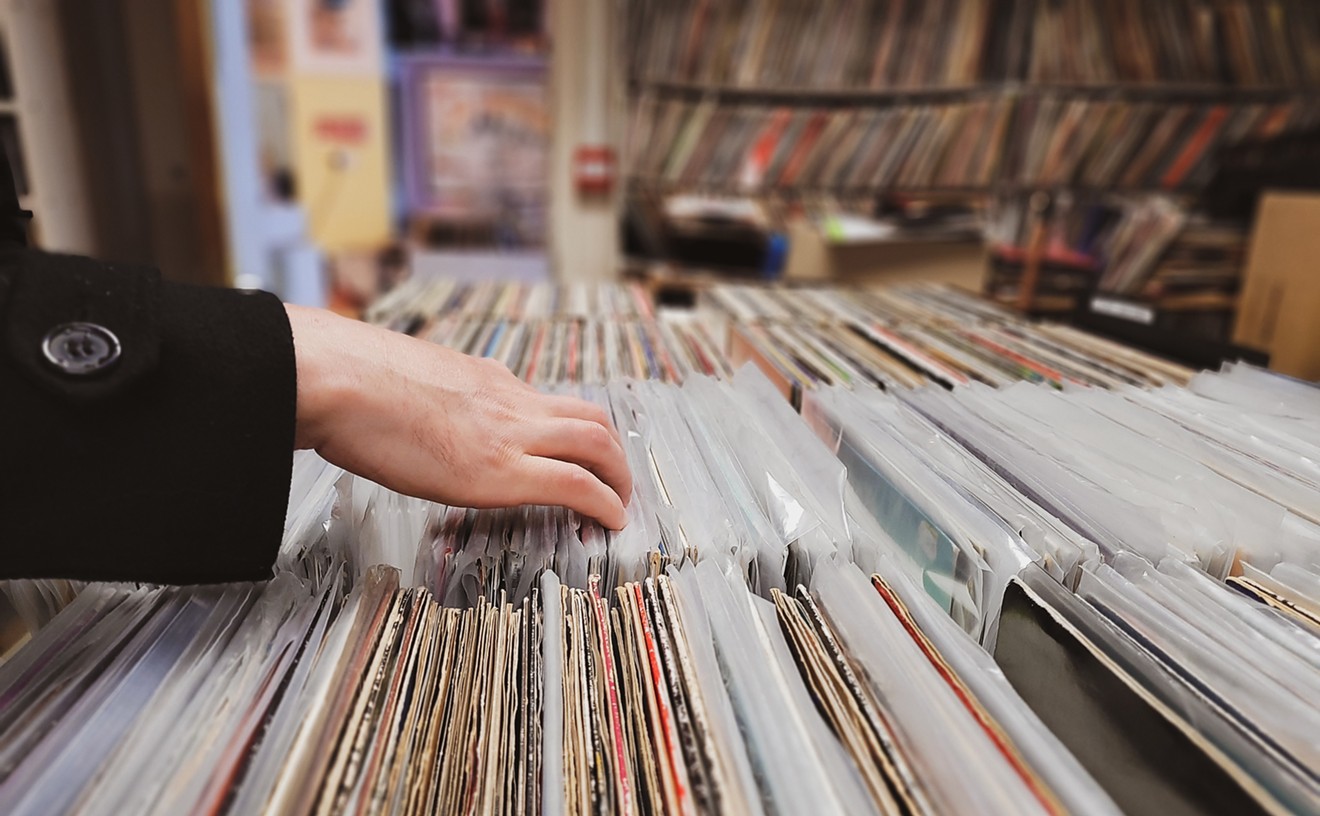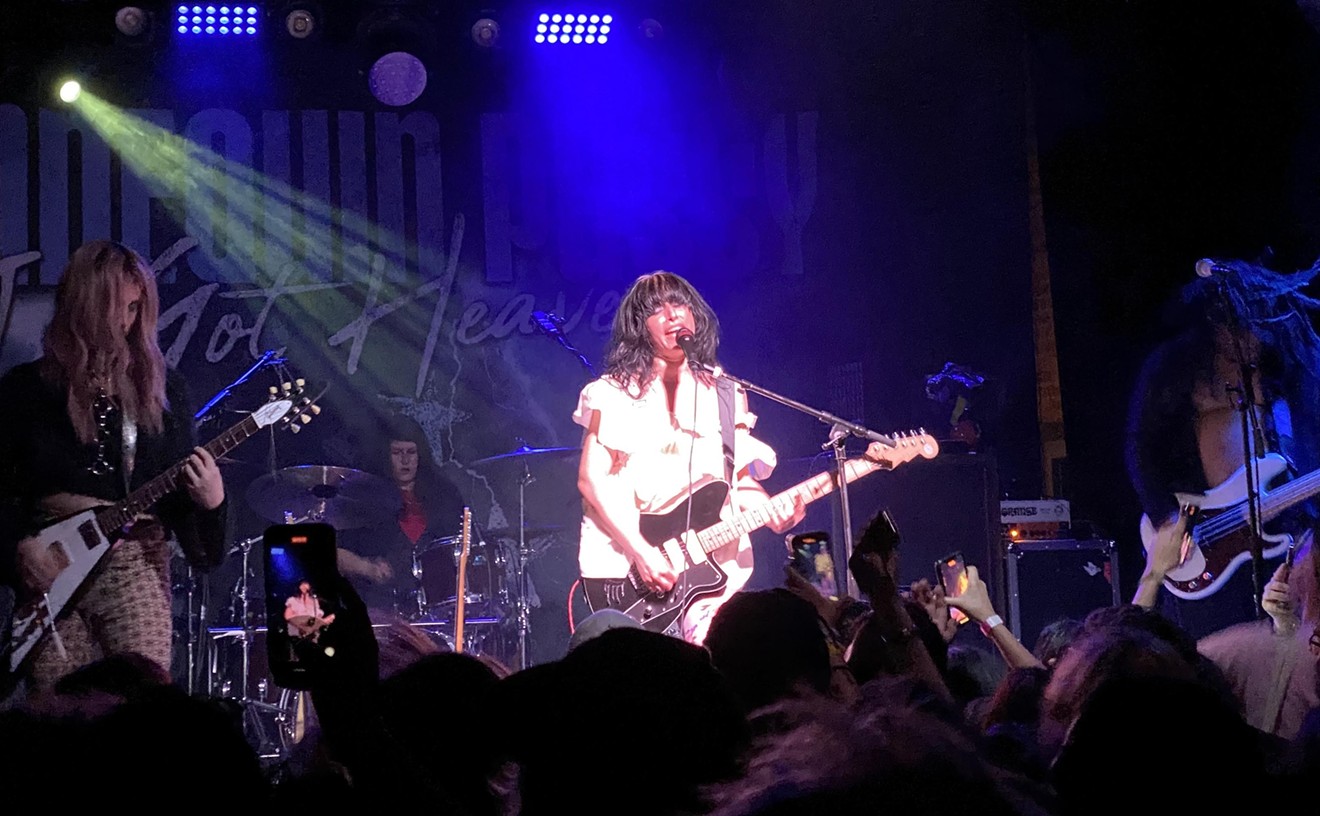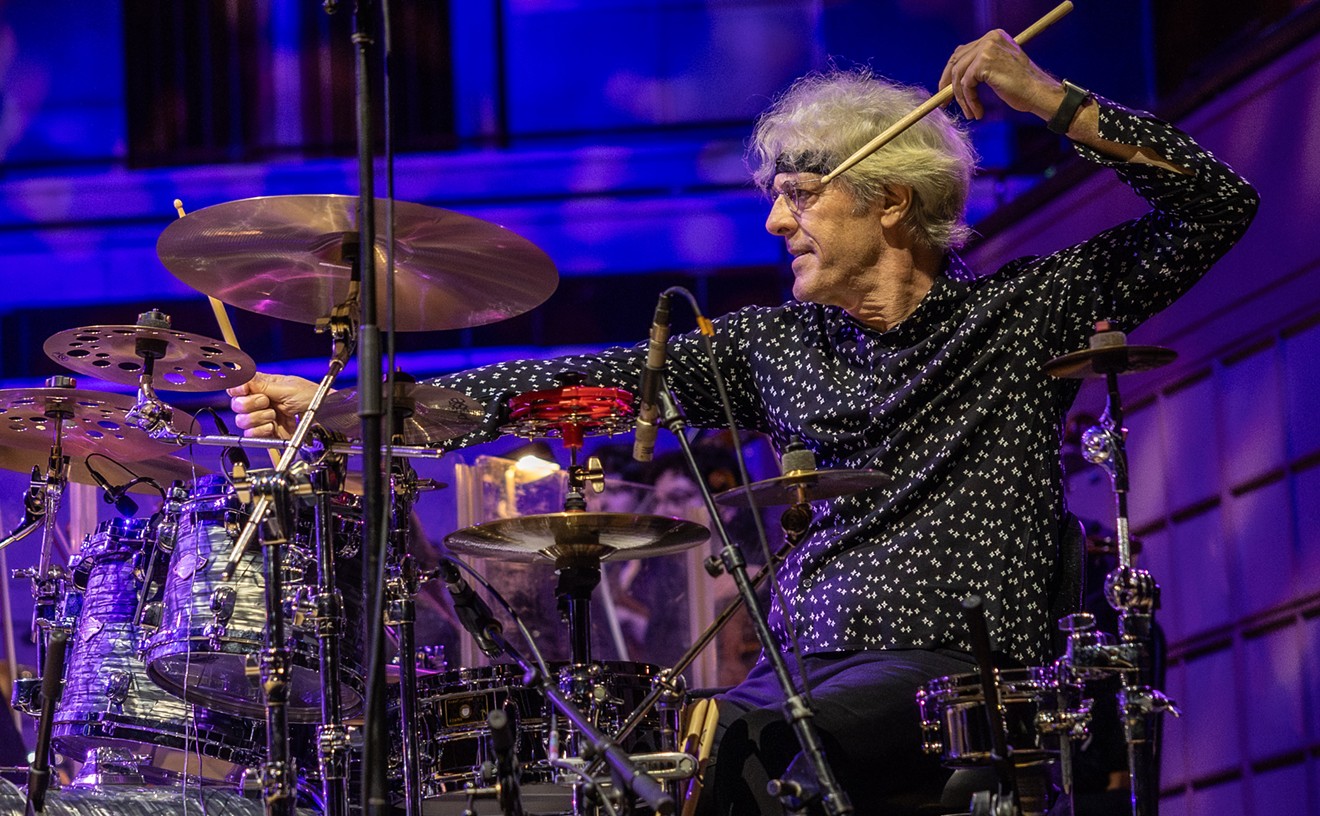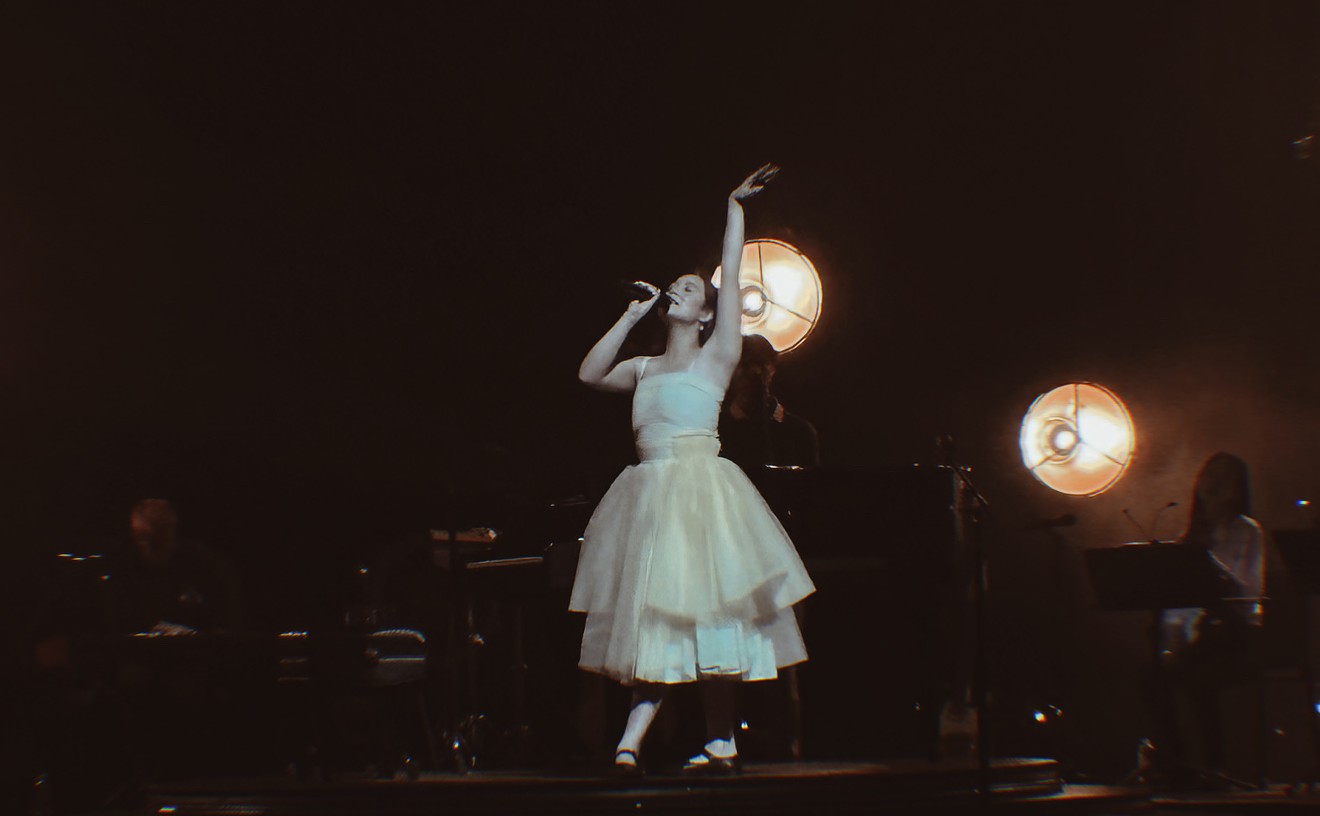Noise is not for everybody.
Some people hear a jackhammer on the street corner and promptly cover their ears; others hear a subsonic melody and random harmonic movement in the staccato repetition of mechanized machinery.
“Industrial music” is the umbrella term used to describe artists who eschew acoustic or organic instrumentation for equipment like samplers, sequencers, and the odd chunk of found metal. Vocals aren’t so much sung as spoken or bleated repeatedly as if coming from a military drill sergeant. The tone is usually quite serious and utilitarian, totally devoid of any sense of humor.
Rule of thumb: If the audience is smiling, the artist must suck. Over the past three decades the definition of industrial music has become even more oblique; popular groups like Ministry, Nine Inch Nails and Marilyn Manson have incorporated various elements of replicated mechanized noise within the context of mainstream dance music. Other groups like Skinny Puppy, Consolidated and Pigface have leveraged industrial noise as a backdrop to message politics and human rights issues.
MC 900 Ft Jesus and DJ Zero in 1990
Those of you who are my age probably met Mark Griffin (aka MC 900 Ft Jesus) during the 80’s, when he worked for almost a decade at VVV, an influential indie record store that was located in Oak Lawn. Mark was always about a month ahead of everybody else when it came to discovering new music.
He still remembers when “industrial” music first started showing up on the radar. “I came into it from the academic end of it; as an undergrad student I studied German composers like Karl Heinz Stockhausen, who would create these repetitive pieces that incorporated lots of found materials,” Griffin says. “And I was really fascinated by this concept—like, say, the idea that people were using machine guns as musical instruments; so much so that I would actually buy textbooks on the subject that weren’t even part of the normal curriculum.”
Griffin first heard the term “industrial music” in relation to an early ’80s record label of the same name: “Genesis P-Orridge of Throbbing Gristle was one of the very first people behind it. This label called Industrial Music released early records by Caberet Voltaire, Clock DVA and, of course his own band, Throbbing Gristle. This was somewhere around 1982 or ’83, I believe. After they broke up, two of their members went on to form Chris and Cosey, and then Genesis started Psychic TV.”
VVV Records was a great place to discover interesting new shit. Griffin and owner Neal Caldwell were both into the Wax Trax label out of Chicago and the Nettwerk Records scene coming out of Vancouver, Canada. And they loved the ideas that these records came without shrink-wrap—it enabled them to play records for customers beforehand.
When Griffin released his first album as MC 900 Ft Jesus, he did so on the Nettwerk label. This affiliation brought his record credibility with the industrial crowd.
“At first, my main motivation was just being able to sell enough of them to recoup the money I had spent producing and manufacturing the record,” he says. “By working at VVV, I had already met the people at Nettwerk. I knew they would find the right audience for it.”
In 1985, Theatre Gallery promoted amazing shows by San Francisco artist My Sin (aka Stan Fairbanks), and the LA-based group Savage Republic. Both artists were way ahead of their time. Savage Republic would later inspire the group Crash Worship. Fairbanks (who hung out in the neighborhood long enough to help build the stage at the first Prophet Bar) had an act very similar to that of Trent Reznor, yet pre-dated the debut of Nine Inch Nails by a three or four years.
As the opening act for controversial New York performance artist Karen Finley and Black Flag’s Henry Rollins (doing his first Dallas spoken word reading), My Sin totally stole the show at Theatre Gallery that evening.
No band or instruments; just a guy with a sequencer, sampler and a bunch of TV sets. It was punk attitude with machinery and software rather than traditional instrumentation. The My Sin performance made a lot of Deep Ellum people stand up and notice: This guy was really onto something different.
Dallas soon became an electric beehive for followers of this new mechanical cult of noise. For a large majority of the public, the initial introduction came via a half dozen or so radio programs on community station KNON. Many of the DJs often crossed over back and forth between industrial noise and other genres, blurring the delineation of species and opening up myriad creative possibilities.
Jeff K’s Thud Slap featured international acts like Dessau, 808 State, Front 242 and Laibach; along with Dallas artists like Audio Assault, I.T.T, Psychic Surgery and Lesson 7. (Jeff K was also an employee at Bill’s Records, and also helped to bring the group Prodigy to Dallas for the first time.) During the 80’s he grew up listening to George Gimarc’s Rock and Roll Alternative, so his presentation was very much like Gimarc’s: very informative, lots of back story on the artists.
Owl and Audrey’s weekly HA! on KNON incorporated groups like Front 242, Coil, Throbbing Gristle, Foetus, My Life With The Thrill Kill Kult, and Young Gods into the mix. Texas artists like Houston’s Painteens, Austin-based Skatenigs, and Trance Records artist Crust were all introduced on HA!
My Wednesday night show was called Life Is Hard. The typical play list brought together industrial groups like Skinny Puppy and Tackhead with early hip-hop artists like Public Enemy, Beastie Boys, Eazy E and NWA… as well as the occasional speed metal groups like Slayer and Motorhead tossed in to keep everyone awake. Dallas-based Rigor Mortis once set up in the control booth and performed live on the show. Club DJ Joe Virus (real name: Joe Gonzalez) gives props to the late Rob Spray (aka DJ Stereotype) as a particularly influential disc jockey during this era.
“DJ Stereotype had the Grey Zone show on KNON for years,” says Gonzalez. “He played a wide mix of industrial, goth, punk, and techno. You would see him at all the underground shows and he would have killer KNON benefit concerts with local industrial bands filling up the bill.”
Spray was a prominent supporter of our local artists.
The menu of North Texas noise artists over the last 20 years sounds like some end-of-the-world shit. Check it out: Species; Post Mortem Statement; Apparatus; Steel Porn Rhino; International Thief Thief; Puncture; Audio Paradox; Threshold; Crash Worship; Blixaboy; Hard Sector Error; Cyberwhore; Bleed and Weld; Charred.
Even ’90s-era Deep Ellum groups Ugly Mus-tard , Chain Link Fence and Course of Empire had definitive elements of industrial influence in their music.
Right this way, folks. (Marcia Cirillo)
Besides VVV, a lot of us discovered industrial music by hanging out at three other influential local record stores: the Record Gallery on Lower Greenville Avenue, Bill’s Records in North Dallas and Tunnelwerks in Deep Ellum. Those who embraced the culture read Re/Search magazine and bought the huge European subway posters. Some gobbled ecstasy or shot speed and watched Blade Runner and Mad Max. Those with a turntable and enough disposable income grabbed every Einstuerzende Neubauten, Young Gods or Zoviet France 12” they could get their hands on.
This was some serious lifestyle shit. The fashion element represented commitment and personality. Shiny black boots and expensive rubber underwear. Ball gags and cod pieces. Tell Deiter to let go of my crotch.
Located just down the block from the current location of Good Records, Record Gallery was one of the first to feature the work of local visual artists as well.
“Record Gallery, as far as I know, has been the template for so many Texas record stores,” says former Dallas DJ Darren Ryan. “It's a simple enough concept; take a record shop, put art on the walls: Record Gallery.”
Owner/operator Steve Stokes lived in the adjacent upstairs loft space. Over the years, Stokes turned me onto everything from Ministry (the Adrian Sherwood 12” remix of “Over The Shoulder” was my first purchase at the store) to Severed Heads, Sister Machine Gun and Chemlab.
“Record Gallery had a certain atmosphere,” recalls Ryan, now living in Austin. “We played really bizarre electronic and industrial music and burned incense constantly. The place just felt otherworldly; there were no windows and a black light art room. As weird as all of that sounds, people felt really comfortable there.”
Stokes (aka “Martian Neon Creature”) hosted a popular late night program on KNON called Radio Soiree. His weekly play list featured a number of early industrial and ambient electronic artists, but it was eventually cancelled by station program director Craig Taylor when he decided there was a conflict of interest relating to Stokes’ ownership of the record store. Many of the records that I played on my own show were purchased at the shop.
“I blew loads of cash at The Record Gallery, “says former Forbidden Books owner Jason Cohen. “For years I put on a monthly event at Galaxy Club called ‘The Orgone Mystery Evening’, which was a showcase for local Avant-Garde, performance art and industrial music,” says Cohen, who was also a founding member of the Dallas group Vas Deferens Organization.. “A great aspect to the industrial scene was the fact we had the Finn brothers from Fort Worth, who documented most of the industrial bands on video. Dan Plunket also published ND Magazine, one of the best serious journals in the world that documented and reviewed industrial and experimental music.“
Joe Virus points to Cohen’s Forbidden Books shop in Expo Park as another key piece to the puzz: “I first heard about Forbidden from some friends at The ChURcH one night during the mid-’90s, and soon discovered that I could rent music videos from Nocturnal Emissions, SPK, and Throbbing Gristle, and also buy CDs by Legendary Pink Dots and magazines like Skin Two.”
“The place was decorated with twisted toys, creepy paintings, old medical supplies, and sculptures made of animal bones,” he says. Like Jason Cohen and Steve Stokes, most hardcore noise fans were also into Survival Research Laboratories, a group of artists who built weird mechanical structures and blew up robots in the desert. In a lot of ways this artist collective was a logical precursor to all of the post-nuclear freaks who now populate the Burning Man festival every year.
My own Decadent Dub Team started out as a logical extension of the Life Is Hard radio show. Our primary inspiration was Tackhead, Mark Stewart + Maffia, Fats Comet and lot of abstract hip-hop projects which ultimately fell by default into the industrial subgenre.
There was three of us in the original incarnation of DDT. Paul Quigg and David Williams played samplers, analog synthesizers and drum machines; and I found the spoken audio sound bytes and scratched vinyl spoken word records on an old cheap turntable.
A lot of the drum sounds and sampled noise we incorporated sounded metallic and percussive source materials; the industrial crowd loved it, but we wouldn’t wear their uniform. None of us could afford to buy rubber clothes. Quigg’s initial fascination with this style of music came from reading an essay by an Italian composer named Luigi Russolo called “The Art of Noises”. The theme was premised on the idea that the human ear had become accustomed to the sound of mechanized machinery, and that this type of noise would eventually become part of our collective musical composition process. (This was where the UK group Art of Noise would get their name and initial inspiration.)
Mark Griffin recalls absorbing that same essay in a different context. “I still have this really great old compilation album of industrial artists, and one of the tracks is a reading of that essay set against the backdrop of that same kind of Stockhausen music,” he says.
“I was friends with a Dallas musician named Will Clay, who played a number of New Wave bands in Dallas during the late ’70s and early ’80s,” recalls Quigg. “Will’s father was Dr. Jack Clay, an SMU theatre director. He would turn us on to all sorts music that was totally outside of the realm of imagination. At this same time, Will and I would get together in his parent’s basement and make this music that had no vocals or obvious melodic structure.”
In 1986, the time was right for a project like Decadent Dub Team. I actually thought of the name while rinsing off in the shower one morning. Quigg, Williams and I would get together at Paul’s loft space at the Mitchell Building in Deep Ellum, smoke a lot of Jamaican pot and then experiment with random slabs of rhythmic noise. We would loop up funky breaks out of everything from Bad Company to Ornette Coleman. It wasn’t about creating something from scratch; it was more about the radical juxtaposition and layering of dissonant noise and funky-ass shit.
Our first handful of live shows included opening slots on bills with Tackhead, Gary Clail and Swans. At the Tackhead/Fats Comet show at Empire (now known as Lizard Lounge) we were flattered that their producer Adrian Sherwood willingly provided the live mix for our set. Drummer Keith LeBlanc and Sherwood took us out to dinner after sound check and we reciprocated by getting them stoned at my apartment next to Moon Mansion.
Will Clay
There weren’t a lot of groups borrowing from both the industrial gene pool and the still-new hip-hop genre at the time; DDT had that in common with the Tackhead crew. By the end of that year, we had placed a song on Island Records’ The Sound of Deep Ellum compilation album, and our first single “Six Gun” had been remixed by a 19-year-old Dr. Dre and included on the soundtrack to the Dennis Hopper-directed film Colors. It was Dre’s first ever remix-for-hire. Island Records paid him 500 bucks to do it.
Meanwhile, gears were really grinding on the local club scene downtown. Nightspots like Starck Club, Empire, Industry and Club Clearview all promoted shows by internationally known acts like Chris and Cosey, Front Line Assembly, Psychic TV and Severed Heads. During this same time period I was also managing Rigor Mortis, the only local speed metal band to have found a home and a following in Deep Ellum. The band agreed to a deal with Capitol Records; and our A&R rep was Rachel Matthews.
Matthews and I shared a love for Skinny Puppy, also signed to the same label at the time. SP collaborator David Ogilvie was tapped to produce the debut Rigor Mortis album for Capitol. Rachel and I figured that raves would help the band make a sort of crossover speed metal record that would also appeal to the industrial music community.
This really wasn’t that far-fetched of an idea. Rick Rubin had just recorded Slayer’s Reign in Blood and was using an affiliation with Def Jam Records to establish credibility with kids who also listened to hip-hop music.
Why couldn’t we do the same thing with a similar band in a different genre? It wasn’t long before everybody was mix-and-matchin’ all kinds of sonic goop. Kerry King from Slayer played on the Beastie Boys’ debut record. Rev. Horton Heat brought Ministry’s Al Jourgensen to Dallas to produce one of his albums.
A few years later, Rigor Mortis lead guitarist Mike Scaccia would join Ministry as full-time member. He has also recorded with Revolting Cocks and 1000 Homo DJs. Scaccia has to be the fastest guitar player on Earth. (RM recently reunited and played at OzzFest.)
Dedicated fans of the industrial genre love to debate the importance of their favorite performances over the last couple of decades. The Chris and Cosey/SPK show at Starck Club was legendary, while the Ministry gig at the Sportatorium found the band peaking on more than just its popularity. K.M.F.D.M.’s show at Trees (seen at the top of this post) was kinda like a Nazi pep rally, while Swans performance at Club Clearview was like a glimpse into Hell.
Most lifers point to an early appearance by Nine Inch Nails at the Video Bar in Deep Ellum as one of the best shows in the history of the neighborhood; while Skinny Puppy’s 1992 gut-wrenching performance at the Bronco Bowl (seen below) certainly raised the bar on subversive performance art.
Career gear heads will tell you that this barely scratches the surface of what has transpired within the context of the noise music scene in Dallas over the last couple of decades. A lot of experimental music never makes it out of the garage or practice room.
Griffin recalls the thrill of doing the very first MC 900 Ft Jesus recordings: “I started out when [local musician] David Dennard would lend me his Tascam four-track recorder; I had a brand new sampler and I would just lock myself in my apartment for a whole weekend and just create stuff. That was really fun and inspiring.”
These days, Griffin is content to work at a book store and do a weekly Thursday night DJ gig at Lee Harvey’s.
“Yeah, all of my musical gear is in storage right now,” he says. “I just haven’t felt like doing much creatively. If I ever did do it again, it would be something totally different than what I was doing before.”
Today the Industrial community still gravitates towards Lizard Lounge, a building with a substantial, enduring legacy. The ChURcH has been home base for the latex-and-spikes set for over 15 years now. DJs like “Reverend” Karl Vought, Joe Virus, Lord Byron, Eric Beck, Angry John and the late Jasper 23 have each brought their signature styles to the ChURcH pulpit over the years.
Sampled noise and sequenced beats are their common denominator. Atonal dissonance is the hot rock in their crack pipe.
I think the linear theme is something along the lines of “technology will only expedite the eventual downfall of mankind.”
So don’t say that I never warned you. --Jeffrey Liles










